University Nursing: Reflective Practice Report, CHCPRP003, HLT54115
VerifiedAdded on 2022/09/15
|13
|4112
|22
Report
AI Summary
This report, prepared for the HLT54115 Diploma of Nursing, focuses on reflective practice within a healthcare setting. It emphasizes the importance of reflective practice in improving the quality of care and enhancing patient outcomes. The report delves into how reflective practice aligns with professional standards, including the responsibilities of nurses to patients and the profession. It also explores the principles of person-centered care, self-evaluation techniques like goal setting, performance management, and time management, and the development of personal development plans. The report also discusses the impact of personal behavior, self-awareness, and learning styles on professional practice, including feedback delivery.
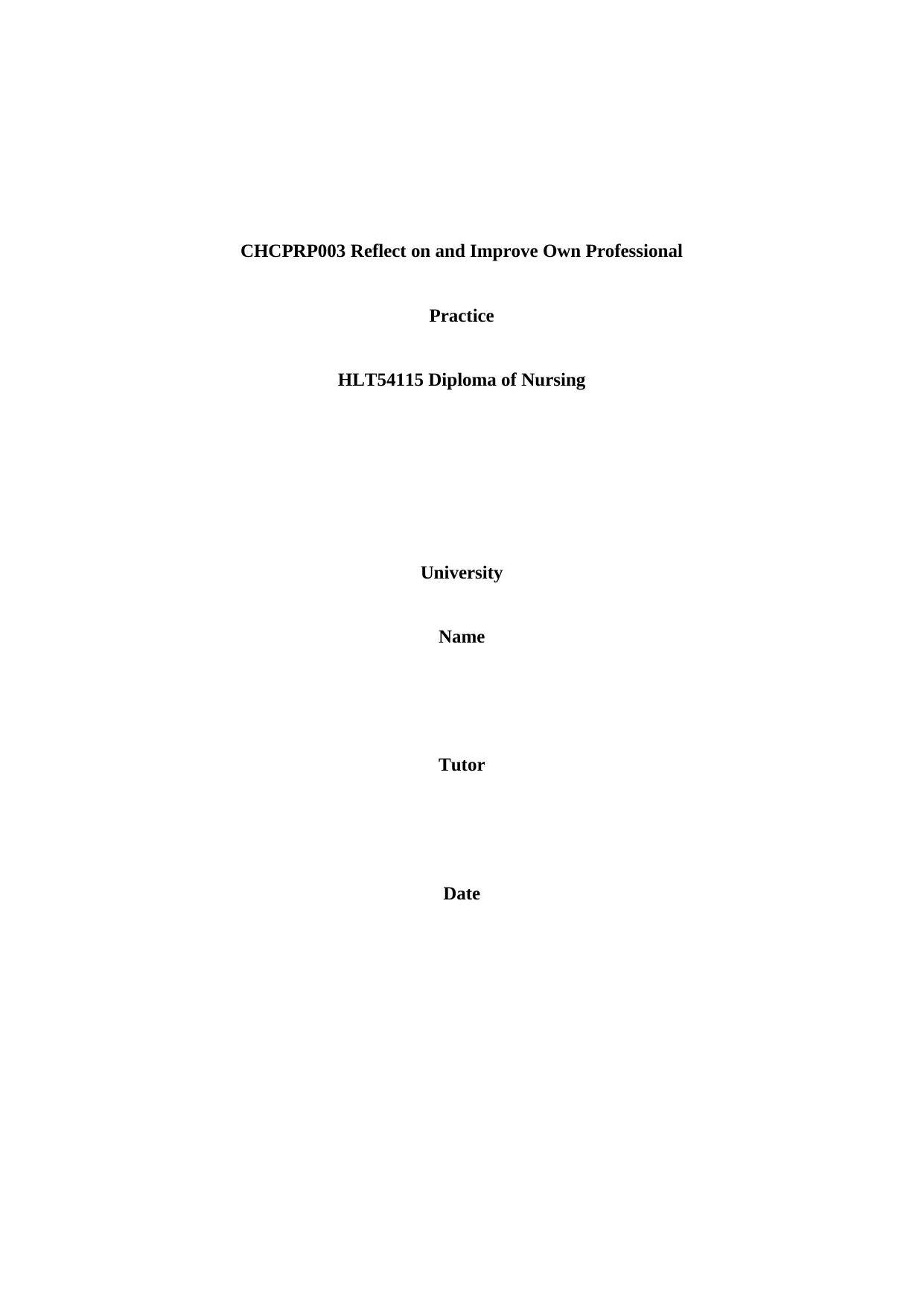
CHCPRP003 Reflect on and Improve Own Professional
Practice
HLT54115 Diploma of Nursing
University
Name
Tutor
Date
Practice
HLT54115 Diploma of Nursing
University
Name
Tutor
Date
Paraphrase This Document
Need a fresh take? Get an instant paraphrase of this document with our AI Paraphraser
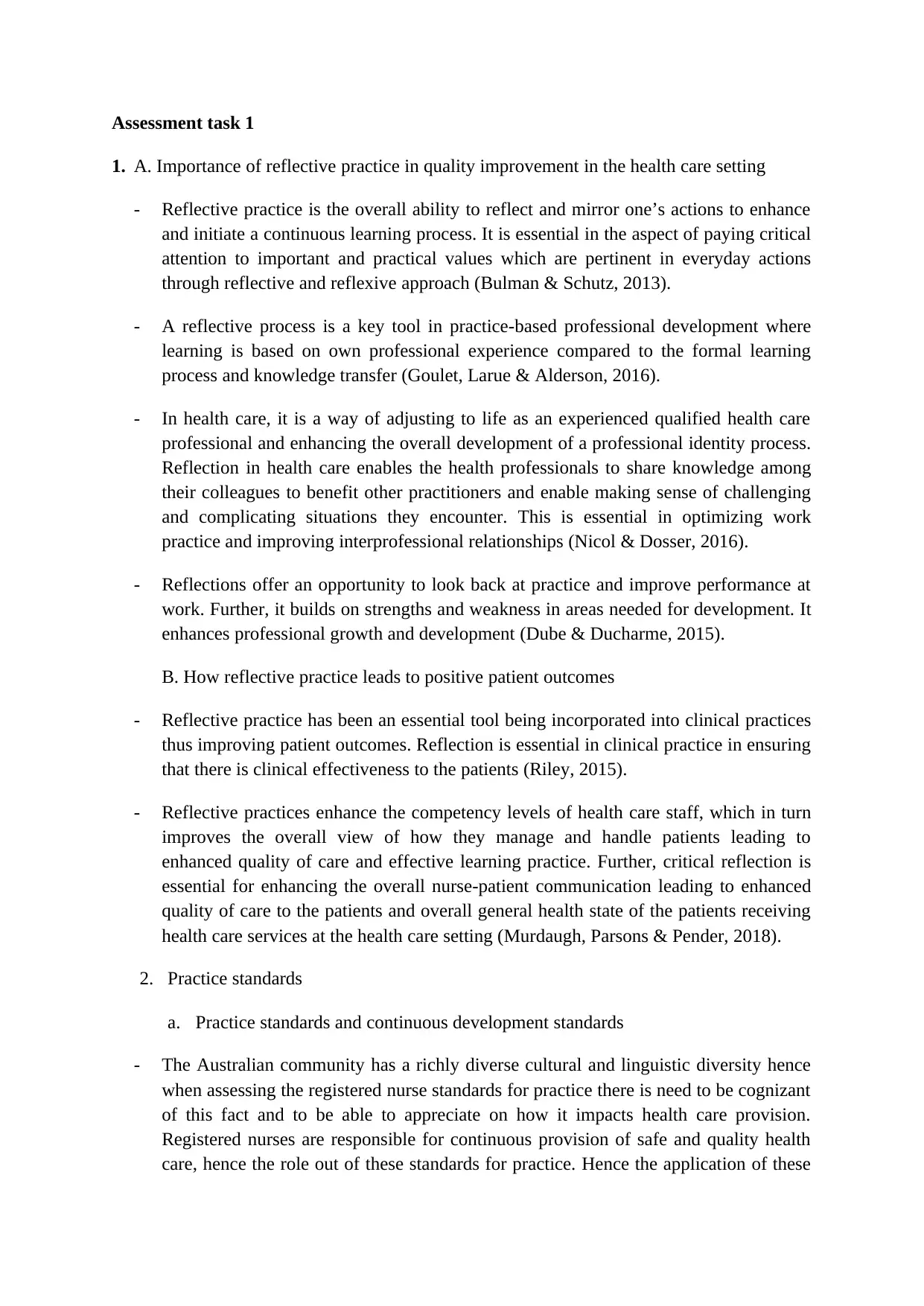
Assessment task 1
1. A. Importance of reflective practice in quality improvement in the health care setting
- Reflective practice is the overall ability to reflect and mirror one’s actions to enhance
and initiate a continuous learning process. It is essential in the aspect of paying critical
attention to important and practical values which are pertinent in everyday actions
through reflective and reflexive approach (Bulman & Schutz, 2013).
- A reflective process is a key tool in practice-based professional development where
learning is based on own professional experience compared to the formal learning
process and knowledge transfer (Goulet, Larue & Alderson, 2016).
- In health care, it is a way of adjusting to life as an experienced qualified health care
professional and enhancing the overall development of a professional identity process.
Reflection in health care enables the health professionals to share knowledge among
their colleagues to benefit other practitioners and enable making sense of challenging
and complicating situations they encounter. This is essential in optimizing work
practice and improving interprofessional relationships (Nicol & Dosser, 2016).
- Reflections offer an opportunity to look back at practice and improve performance at
work. Further, it builds on strengths and weakness in areas needed for development. It
enhances professional growth and development (Dube & Ducharme, 2015).
B. How reflective practice leads to positive patient outcomes
- Reflective practice has been an essential tool being incorporated into clinical practices
thus improving patient outcomes. Reflection is essential in clinical practice in ensuring
that there is clinical effectiveness to the patients (Riley, 2015).
- Reflective practices enhance the competency levels of health care staff, which in turn
improves the overall view of how they manage and handle patients leading to
enhanced quality of care and effective learning practice. Further, critical reflection is
essential for enhancing the overall nurse-patient communication leading to enhanced
quality of care to the patients and overall general health state of the patients receiving
health care services at the health care setting (Murdaugh, Parsons & Pender, 2018).
2. Practice standards
a. Practice standards and continuous development standards
- The Australian community has a richly diverse cultural and linguistic diversity hence
when assessing the registered nurse standards for practice there is need to be cognizant
of this fact and to be able to appreciate on how it impacts health care provision.
Registered nurses are responsible for continuous provision of safe and quality health
care, hence the role out of these standards for practice. Hence the application of these
1. A. Importance of reflective practice in quality improvement in the health care setting
- Reflective practice is the overall ability to reflect and mirror one’s actions to enhance
and initiate a continuous learning process. It is essential in the aspect of paying critical
attention to important and practical values which are pertinent in everyday actions
through reflective and reflexive approach (Bulman & Schutz, 2013).
- A reflective process is a key tool in practice-based professional development where
learning is based on own professional experience compared to the formal learning
process and knowledge transfer (Goulet, Larue & Alderson, 2016).
- In health care, it is a way of adjusting to life as an experienced qualified health care
professional and enhancing the overall development of a professional identity process.
Reflection in health care enables the health professionals to share knowledge among
their colleagues to benefit other practitioners and enable making sense of challenging
and complicating situations they encounter. This is essential in optimizing work
practice and improving interprofessional relationships (Nicol & Dosser, 2016).
- Reflections offer an opportunity to look back at practice and improve performance at
work. Further, it builds on strengths and weakness in areas needed for development. It
enhances professional growth and development (Dube & Ducharme, 2015).
B. How reflective practice leads to positive patient outcomes
- Reflective practice has been an essential tool being incorporated into clinical practices
thus improving patient outcomes. Reflection is essential in clinical practice in ensuring
that there is clinical effectiveness to the patients (Riley, 2015).
- Reflective practices enhance the competency levels of health care staff, which in turn
improves the overall view of how they manage and handle patients leading to
enhanced quality of care and effective learning practice. Further, critical reflection is
essential for enhancing the overall nurse-patient communication leading to enhanced
quality of care to the patients and overall general health state of the patients receiving
health care services at the health care setting (Murdaugh, Parsons & Pender, 2018).
2. Practice standards
a. Practice standards and continuous development standards
- The Australian community has a richly diverse cultural and linguistic diversity hence
when assessing the registered nurse standards for practice there is need to be cognizant
of this fact and to be able to appreciate on how it impacts health care provision.
Registered nurses are responsible for continuous provision of safe and quality health
care, hence the role out of these standards for practice. Hence the application of these
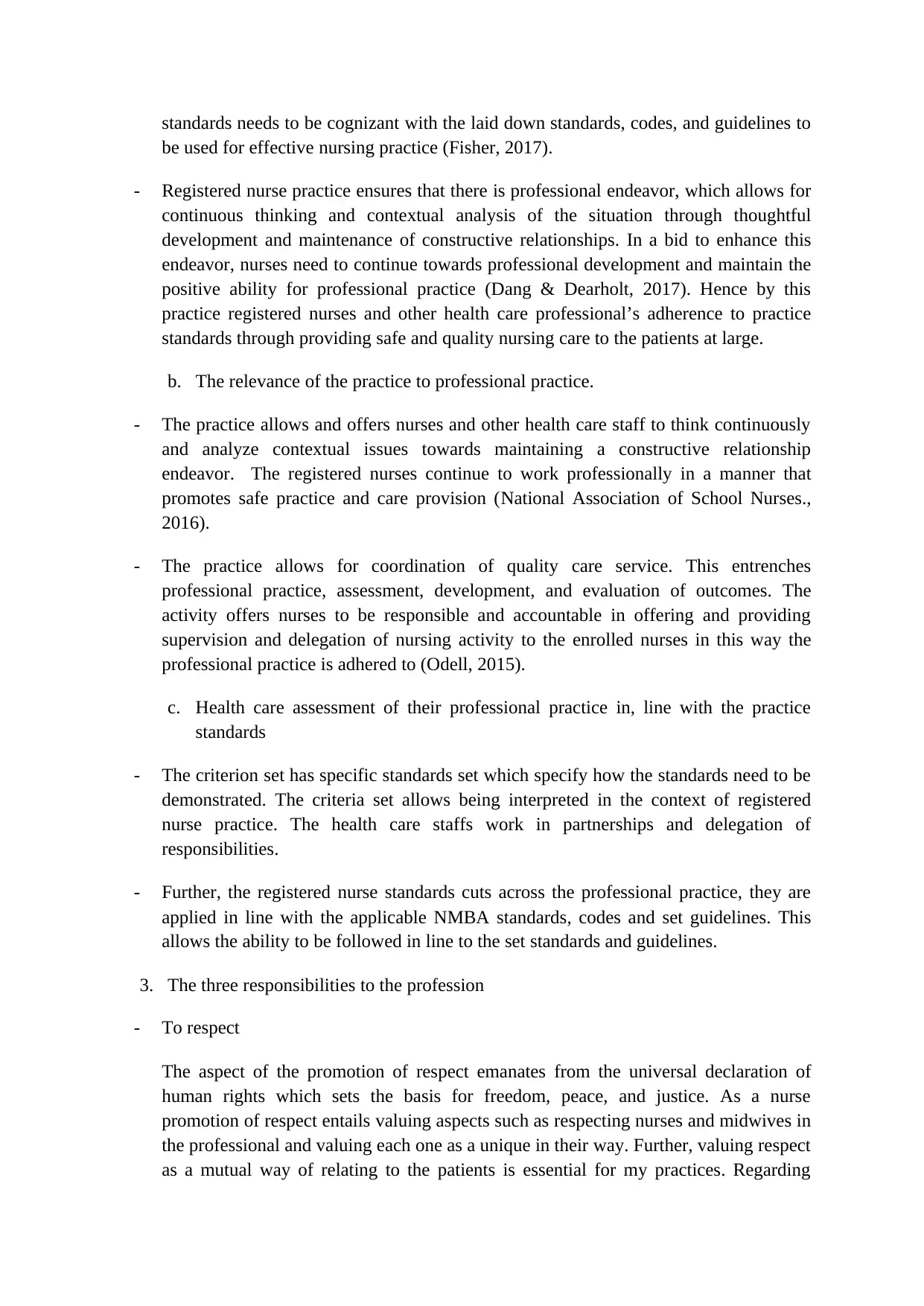
standards needs to be cognizant with the laid down standards, codes, and guidelines to
be used for effective nursing practice (Fisher, 2017).
- Registered nurse practice ensures that there is professional endeavor, which allows for
continuous thinking and contextual analysis of the situation through thoughtful
development and maintenance of constructive relationships. In a bid to enhance this
endeavor, nurses need to continue towards professional development and maintain the
positive ability for professional practice (Dang & Dearholt, 2017). Hence by this
practice registered nurses and other health care professional’s adherence to practice
standards through providing safe and quality nursing care to the patients at large.
b. The relevance of the practice to professional practice.
- The practice allows and offers nurses and other health care staff to think continuously
and analyze contextual issues towards maintaining a constructive relationship
endeavor. The registered nurses continue to work professionally in a manner that
promotes safe practice and care provision (National Association of School Nurses.,
2016).
- The practice allows for coordination of quality care service. This entrenches
professional practice, assessment, development, and evaluation of outcomes. The
activity offers nurses to be responsible and accountable in offering and providing
supervision and delegation of nursing activity to the enrolled nurses in this way the
professional practice is adhered to (Odell, 2015).
c. Health care assessment of their professional practice in, line with the practice
standards
- The criterion set has specific standards set which specify how the standards need to be
demonstrated. The criteria set allows being interpreted in the context of registered
nurse practice. The health care staffs work in partnerships and delegation of
responsibilities.
- Further, the registered nurse standards cuts across the professional practice, they are
applied in line with the applicable NMBA standards, codes and set guidelines. This
allows the ability to be followed in line to the set standards and guidelines.
3. The three responsibilities to the profession
- To respect
The aspect of the promotion of respect emanates from the universal declaration of
human rights which sets the basis for freedom, peace, and justice. As a nurse
promotion of respect entails valuing aspects such as respecting nurses and midwives in
the professional and valuing each one as a unique in their way. Further, valuing respect
as a mutual way of relating to the patients is essential for my practices. Regarding
be used for effective nursing practice (Fisher, 2017).
- Registered nurse practice ensures that there is professional endeavor, which allows for
continuous thinking and contextual analysis of the situation through thoughtful
development and maintenance of constructive relationships. In a bid to enhance this
endeavor, nurses need to continue towards professional development and maintain the
positive ability for professional practice (Dang & Dearholt, 2017). Hence by this
practice registered nurses and other health care professional’s adherence to practice
standards through providing safe and quality nursing care to the patients at large.
b. The relevance of the practice to professional practice.
- The practice allows and offers nurses and other health care staff to think continuously
and analyze contextual issues towards maintaining a constructive relationship
endeavor. The registered nurses continue to work professionally in a manner that
promotes safe practice and care provision (National Association of School Nurses.,
2016).
- The practice allows for coordination of quality care service. This entrenches
professional practice, assessment, development, and evaluation of outcomes. The
activity offers nurses to be responsible and accountable in offering and providing
supervision and delegation of nursing activity to the enrolled nurses in this way the
professional practice is adhered to (Odell, 2015).
c. Health care assessment of their professional practice in, line with the practice
standards
- The criterion set has specific standards set which specify how the standards need to be
demonstrated. The criteria set allows being interpreted in the context of registered
nurse practice. The health care staffs work in partnerships and delegation of
responsibilities.
- Further, the registered nurse standards cuts across the professional practice, they are
applied in line with the applicable NMBA standards, codes and set guidelines. This
allows the ability to be followed in line to the set standards and guidelines.
3. The three responsibilities to the profession
- To respect
The aspect of the promotion of respect emanates from the universal declaration of
human rights which sets the basis for freedom, peace, and justice. As a nurse
promotion of respect entails valuing aspects such as respecting nurses and midwives in
the professional and valuing each one as a unique in their way. Further, valuing respect
as a mutual way of relating to the patients is essential for my practices. Regarding
⊘ This is a preview!⊘
Do you want full access?
Subscribe today to unlock all pages.

Trusted by 1+ million students worldwide
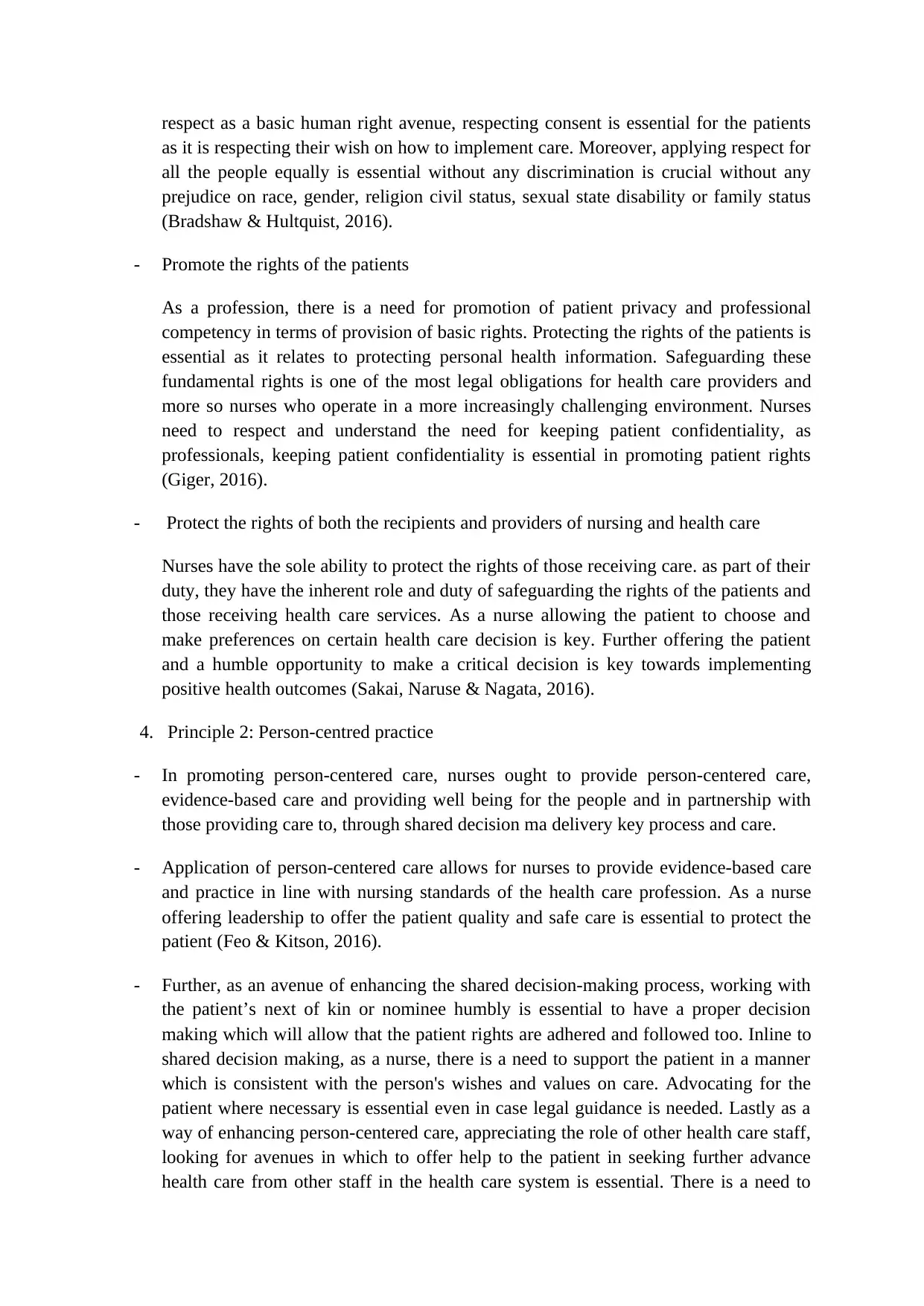
respect as a basic human right avenue, respecting consent is essential for the patients
as it is respecting their wish on how to implement care. Moreover, applying respect for
all the people equally is essential without any discrimination is crucial without any
prejudice on race, gender, religion civil status, sexual state disability or family status
(Bradshaw & Hultquist, 2016).
- Promote the rights of the patients
As a profession, there is a need for promotion of patient privacy and professional
competency in terms of provision of basic rights. Protecting the rights of the patients is
essential as it relates to protecting personal health information. Safeguarding these
fundamental rights is one of the most legal obligations for health care providers and
more so nurses who operate in a more increasingly challenging environment. Nurses
need to respect and understand the need for keeping patient confidentiality, as
professionals, keeping patient confidentiality is essential in promoting patient rights
(Giger, 2016).
- Protect the rights of both the recipients and providers of nursing and health care
Nurses have the sole ability to protect the rights of those receiving care. as part of their
duty, they have the inherent role and duty of safeguarding the rights of the patients and
those receiving health care services. As a nurse allowing the patient to choose and
make preferences on certain health care decision is key. Further offering the patient
and a humble opportunity to make a critical decision is key towards implementing
positive health outcomes (Sakai, Naruse & Nagata, 2016).
4. Principle 2: Person-centred practice
- In promoting person-centered care, nurses ought to provide person-centered care,
evidence-based care and providing well being for the people and in partnership with
those providing care to, through shared decision ma delivery key process and care.
- Application of person-centered care allows for nurses to provide evidence-based care
and practice in line with nursing standards of the health care profession. As a nurse
offering leadership to offer the patient quality and safe care is essential to protect the
patient (Feo & Kitson, 2016).
- Further, as an avenue of enhancing the shared decision-making process, working with
the patient’s next of kin or nominee humbly is essential to have a proper decision
making which will allow that the patient rights are adhered and followed too. Inline to
shared decision making, as a nurse, there is a need to support the patient in a manner
which is consistent with the person's wishes and values on care. Advocating for the
patient where necessary is essential even in case legal guidance is needed. Lastly as a
way of enhancing person-centered care, appreciating the role of other health care staff,
looking for avenues in which to offer help to the patient in seeking further advance
health care from other staff in the health care system is essential. There is a need to
as it is respecting their wish on how to implement care. Moreover, applying respect for
all the people equally is essential without any discrimination is crucial without any
prejudice on race, gender, religion civil status, sexual state disability or family status
(Bradshaw & Hultquist, 2016).
- Promote the rights of the patients
As a profession, there is a need for promotion of patient privacy and professional
competency in terms of provision of basic rights. Protecting the rights of the patients is
essential as it relates to protecting personal health information. Safeguarding these
fundamental rights is one of the most legal obligations for health care providers and
more so nurses who operate in a more increasingly challenging environment. Nurses
need to respect and understand the need for keeping patient confidentiality, as
professionals, keeping patient confidentiality is essential in promoting patient rights
(Giger, 2016).
- Protect the rights of both the recipients and providers of nursing and health care
Nurses have the sole ability to protect the rights of those receiving care. as part of their
duty, they have the inherent role and duty of safeguarding the rights of the patients and
those receiving health care services. As a nurse allowing the patient to choose and
make preferences on certain health care decision is key. Further offering the patient
and a humble opportunity to make a critical decision is key towards implementing
positive health outcomes (Sakai, Naruse & Nagata, 2016).
4. Principle 2: Person-centred practice
- In promoting person-centered care, nurses ought to provide person-centered care,
evidence-based care and providing well being for the people and in partnership with
those providing care to, through shared decision ma delivery key process and care.
- Application of person-centered care allows for nurses to provide evidence-based care
and practice in line with nursing standards of the health care profession. As a nurse
offering leadership to offer the patient quality and safe care is essential to protect the
patient (Feo & Kitson, 2016).
- Further, as an avenue of enhancing the shared decision-making process, working with
the patient’s next of kin or nominee humbly is essential to have a proper decision
making which will allow that the patient rights are adhered and followed too. Inline to
shared decision making, as a nurse, there is a need to support the patient in a manner
which is consistent with the person's wishes and values on care. Advocating for the
patient where necessary is essential even in case legal guidance is needed. Lastly as a
way of enhancing person-centered care, appreciating the role of other health care staff,
looking for avenues in which to offer help to the patient in seeking further advance
health care from other staff in the health care system is essential. There is a need to
Paraphrase This Document
Need a fresh take? Get an instant paraphrase of this document with our AI Paraphraser
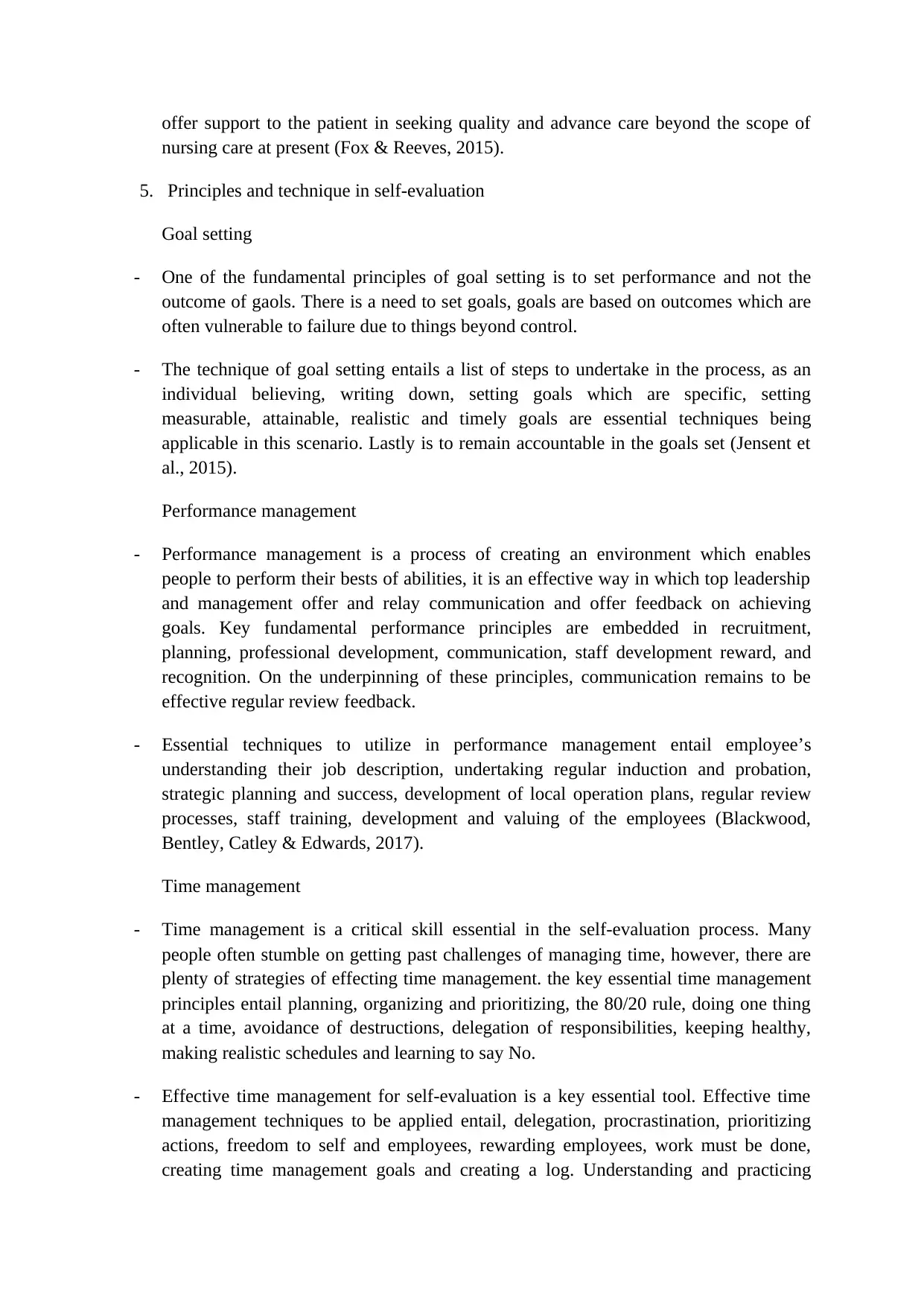
offer support to the patient in seeking quality and advance care beyond the scope of
nursing care at present (Fox & Reeves, 2015).
5. Principles and technique in self-evaluation
Goal setting
- One of the fundamental principles of goal setting is to set performance and not the
outcome of gaols. There is a need to set goals, goals are based on outcomes which are
often vulnerable to failure due to things beyond control.
- The technique of goal setting entails a list of steps to undertake in the process, as an
individual believing, writing down, setting goals which are specific, setting
measurable, attainable, realistic and timely goals are essential techniques being
applicable in this scenario. Lastly is to remain accountable in the goals set (Jensent et
al., 2015).
Performance management
- Performance management is a process of creating an environment which enables
people to perform their bests of abilities, it is an effective way in which top leadership
and management offer and relay communication and offer feedback on achieving
goals. Key fundamental performance principles are embedded in recruitment,
planning, professional development, communication, staff development reward, and
recognition. On the underpinning of these principles, communication remains to be
effective regular review feedback.
- Essential techniques to utilize in performance management entail employee’s
understanding their job description, undertaking regular induction and probation,
strategic planning and success, development of local operation plans, regular review
processes, staff training, development and valuing of the employees (Blackwood,
Bentley, Catley & Edwards, 2017).
Time management
- Time management is a critical skill essential in the self-evaluation process. Many
people often stumble on getting past challenges of managing time, however, there are
plenty of strategies of effecting time management. the key essential time management
principles entail planning, organizing and prioritizing, the 80/20 rule, doing one thing
at a time, avoidance of destructions, delegation of responsibilities, keeping healthy,
making realistic schedules and learning to say No.
- Effective time management for self-evaluation is a key essential tool. Effective time
management techniques to be applied entail, delegation, procrastination, prioritizing
actions, freedom to self and employees, rewarding employees, work must be done,
creating time management goals and creating a log. Understanding and practicing
nursing care at present (Fox & Reeves, 2015).
5. Principles and technique in self-evaluation
Goal setting
- One of the fundamental principles of goal setting is to set performance and not the
outcome of gaols. There is a need to set goals, goals are based on outcomes which are
often vulnerable to failure due to things beyond control.
- The technique of goal setting entails a list of steps to undertake in the process, as an
individual believing, writing down, setting goals which are specific, setting
measurable, attainable, realistic and timely goals are essential techniques being
applicable in this scenario. Lastly is to remain accountable in the goals set (Jensent et
al., 2015).
Performance management
- Performance management is a process of creating an environment which enables
people to perform their bests of abilities, it is an effective way in which top leadership
and management offer and relay communication and offer feedback on achieving
goals. Key fundamental performance principles are embedded in recruitment,
planning, professional development, communication, staff development reward, and
recognition. On the underpinning of these principles, communication remains to be
effective regular review feedback.
- Essential techniques to utilize in performance management entail employee’s
understanding their job description, undertaking regular induction and probation,
strategic planning and success, development of local operation plans, regular review
processes, staff training, development and valuing of the employees (Blackwood,
Bentley, Catley & Edwards, 2017).
Time management
- Time management is a critical skill essential in the self-evaluation process. Many
people often stumble on getting past challenges of managing time, however, there are
plenty of strategies of effecting time management. the key essential time management
principles entail planning, organizing and prioritizing, the 80/20 rule, doing one thing
at a time, avoidance of destructions, delegation of responsibilities, keeping healthy,
making realistic schedules and learning to say No.
- Effective time management for self-evaluation is a key essential tool. Effective time
management techniques to be applied entail, delegation, procrastination, prioritizing
actions, freedom to self and employees, rewarding employees, work must be done,
creating time management goals and creating a log. Understanding and practicing
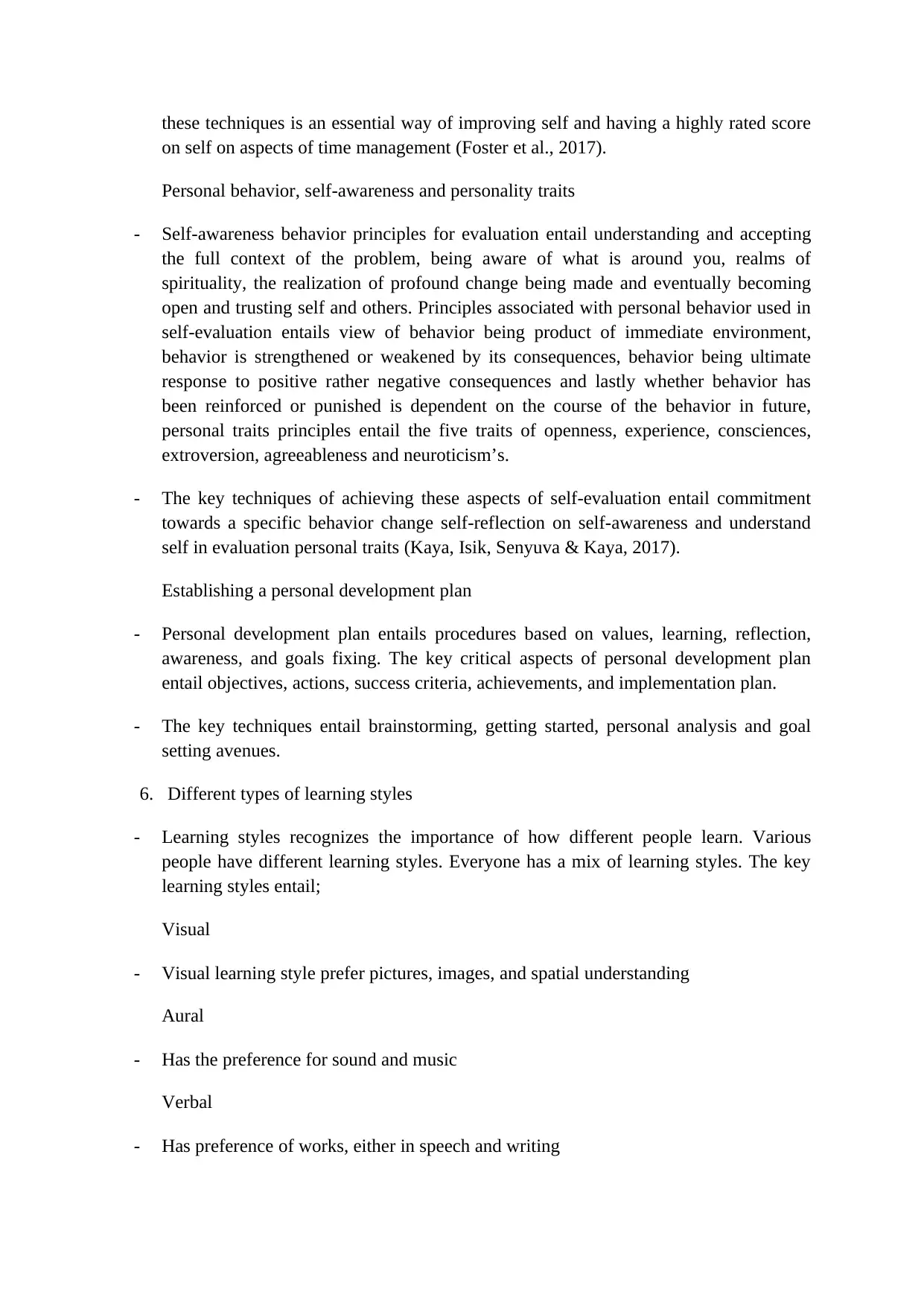
these techniques is an essential way of improving self and having a highly rated score
on self on aspects of time management (Foster et al., 2017).
Personal behavior, self-awareness and personality traits
- Self-awareness behavior principles for evaluation entail understanding and accepting
the full context of the problem, being aware of what is around you, realms of
spirituality, the realization of profound change being made and eventually becoming
open and trusting self and others. Principles associated with personal behavior used in
self-evaluation entails view of behavior being product of immediate environment,
behavior is strengthened or weakened by its consequences, behavior being ultimate
response to positive rather negative consequences and lastly whether behavior has
been reinforced or punished is dependent on the course of the behavior in future,
personal traits principles entail the five traits of openness, experience, consciences,
extroversion, agreeableness and neuroticism’s.
- The key techniques of achieving these aspects of self-evaluation entail commitment
towards a specific behavior change self-reflection on self-awareness and understand
self in evaluation personal traits (Kaya, Isik, Senyuva & Kaya, 2017).
Establishing a personal development plan
- Personal development plan entails procedures based on values, learning, reflection,
awareness, and goals fixing. The key critical aspects of personal development plan
entail objectives, actions, success criteria, achievements, and implementation plan.
- The key techniques entail brainstorming, getting started, personal analysis and goal
setting avenues.
6. Different types of learning styles
- Learning styles recognizes the importance of how different people learn. Various
people have different learning styles. Everyone has a mix of learning styles. The key
learning styles entail;
Visual
- Visual learning style prefer pictures, images, and spatial understanding
Aural
- Has the preference for sound and music
Verbal
- Has preference of works, either in speech and writing
on self on aspects of time management (Foster et al., 2017).
Personal behavior, self-awareness and personality traits
- Self-awareness behavior principles for evaluation entail understanding and accepting
the full context of the problem, being aware of what is around you, realms of
spirituality, the realization of profound change being made and eventually becoming
open and trusting self and others. Principles associated with personal behavior used in
self-evaluation entails view of behavior being product of immediate environment,
behavior is strengthened or weakened by its consequences, behavior being ultimate
response to positive rather negative consequences and lastly whether behavior has
been reinforced or punished is dependent on the course of the behavior in future,
personal traits principles entail the five traits of openness, experience, consciences,
extroversion, agreeableness and neuroticism’s.
- The key techniques of achieving these aspects of self-evaluation entail commitment
towards a specific behavior change self-reflection on self-awareness and understand
self in evaluation personal traits (Kaya, Isik, Senyuva & Kaya, 2017).
Establishing a personal development plan
- Personal development plan entails procedures based on values, learning, reflection,
awareness, and goals fixing. The key critical aspects of personal development plan
entail objectives, actions, success criteria, achievements, and implementation plan.
- The key techniques entail brainstorming, getting started, personal analysis and goal
setting avenues.
6. Different types of learning styles
- Learning styles recognizes the importance of how different people learn. Various
people have different learning styles. Everyone has a mix of learning styles. The key
learning styles entail;
Visual
- Visual learning style prefer pictures, images, and spatial understanding
Aural
- Has the preference for sound and music
Verbal
- Has preference of works, either in speech and writing
⊘ This is a preview!⊘
Do you want full access?
Subscribe today to unlock all pages.

Trusted by 1+ million students worldwide
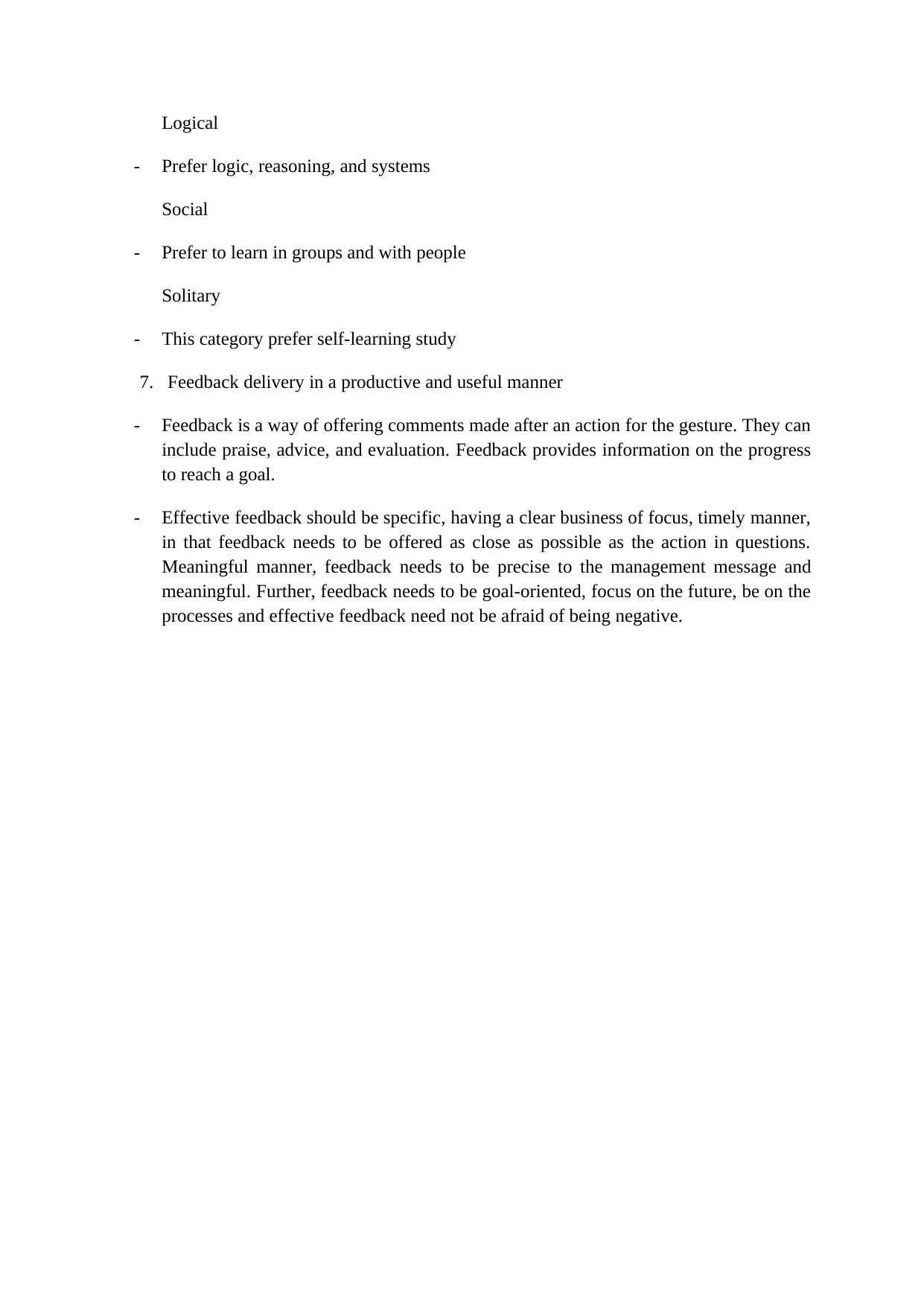
Logical
- Prefer logic, reasoning, and systems
Social
- Prefer to learn in groups and with people
Solitary
- This category prefer self-learning study
7. Feedback delivery in a productive and useful manner
- Feedback is a way of offering comments made after an action for the gesture. They can
include praise, advice, and evaluation. Feedback provides information on the progress
to reach a goal.
- Effective feedback should be specific, having a clear business of focus, timely manner,
in that feedback needs to be offered as close as possible as the action in questions.
Meaningful manner, feedback needs to be precise to the management message and
meaningful. Further, feedback needs to be goal-oriented, focus on the future, be on the
processes and effective feedback need not be afraid of being negative.
- Prefer logic, reasoning, and systems
Social
- Prefer to learn in groups and with people
Solitary
- This category prefer self-learning study
7. Feedback delivery in a productive and useful manner
- Feedback is a way of offering comments made after an action for the gesture. They can
include praise, advice, and evaluation. Feedback provides information on the progress
to reach a goal.
- Effective feedback should be specific, having a clear business of focus, timely manner,
in that feedback needs to be offered as close as possible as the action in questions.
Meaningful manner, feedback needs to be precise to the management message and
meaningful. Further, feedback needs to be goal-oriented, focus on the future, be on the
processes and effective feedback need not be afraid of being negative.
Paraphrase This Document
Need a fresh take? Get an instant paraphrase of this document with our AI Paraphraser
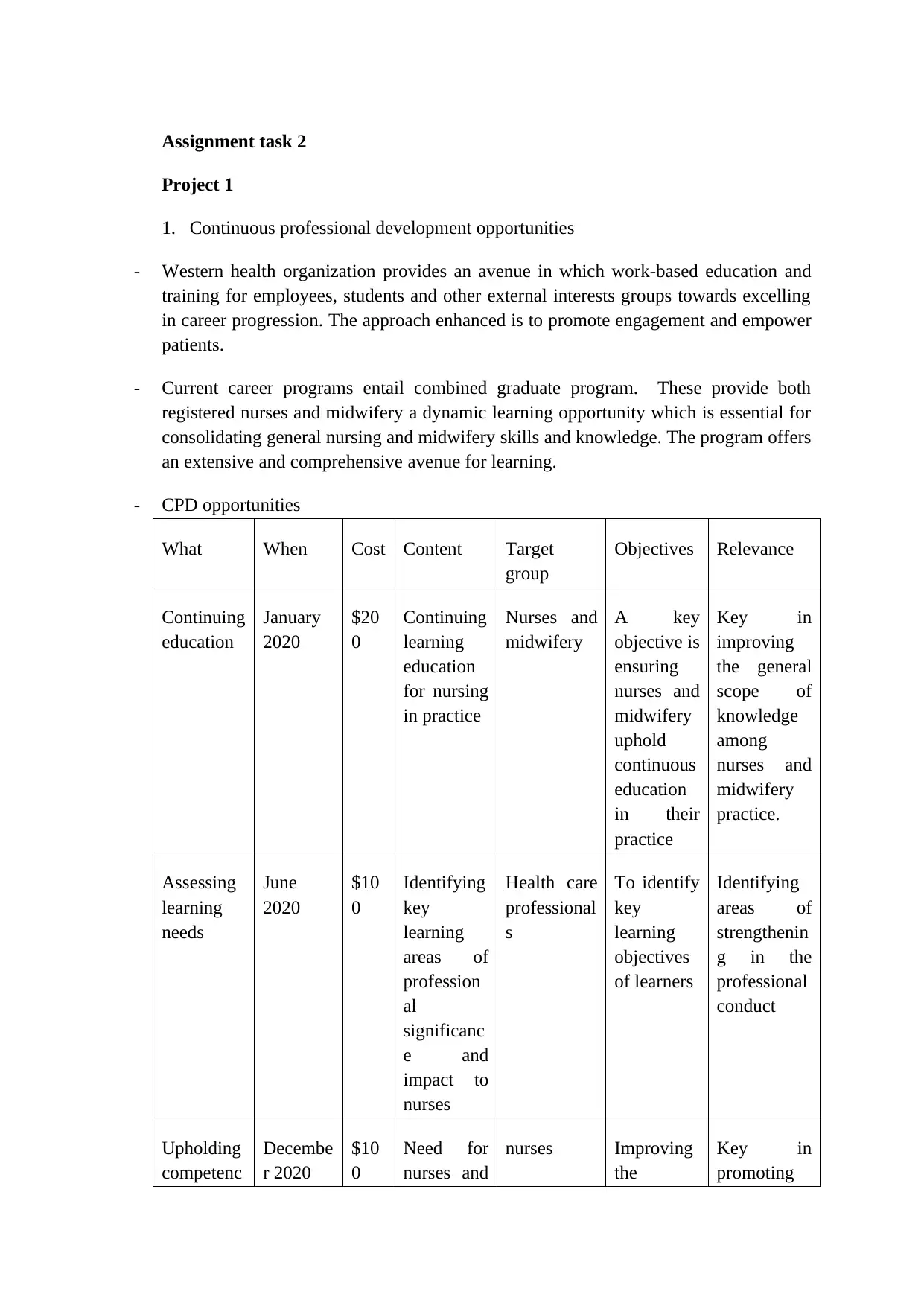
Assignment task 2
Project 1
1. Continuous professional development opportunities
- Western health organization provides an avenue in which work-based education and
training for employees, students and other external interests groups towards excelling
in career progression. The approach enhanced is to promote engagement and empower
patients.
- Current career programs entail combined graduate program. These provide both
registered nurses and midwifery a dynamic learning opportunity which is essential for
consolidating general nursing and midwifery skills and knowledge. The program offers
an extensive and comprehensive avenue for learning.
- CPD opportunities
What When Cost Content Target
group
Objectives Relevance
Continuing
education
January
2020
$20
0
Continuing
learning
education
for nursing
in practice
Nurses and
midwifery
A key
objective is
ensuring
nurses and
midwifery
uphold
continuous
education
in their
practice
Key in
improving
the general
scope of
knowledge
among
nurses and
midwifery
practice.
Assessing
learning
needs
June
2020
$10
0
Identifying
key
learning
areas of
profession
al
significanc
e and
impact to
nurses
Health care
professional
s
To identify
key
learning
objectives
of learners
Identifying
areas of
strengthenin
g in the
professional
conduct
Upholding
competenc
Decembe
r 2020
$10
0
Need for
nurses and
nurses Improving
the
Key in
promoting
Project 1
1. Continuous professional development opportunities
- Western health organization provides an avenue in which work-based education and
training for employees, students and other external interests groups towards excelling
in career progression. The approach enhanced is to promote engagement and empower
patients.
- Current career programs entail combined graduate program. These provide both
registered nurses and midwifery a dynamic learning opportunity which is essential for
consolidating general nursing and midwifery skills and knowledge. The program offers
an extensive and comprehensive avenue for learning.
- CPD opportunities
What When Cost Content Target
group
Objectives Relevance
Continuing
education
January
2020
$20
0
Continuing
learning
education
for nursing
in practice
Nurses and
midwifery
A key
objective is
ensuring
nurses and
midwifery
uphold
continuous
education
in their
practice
Key in
improving
the general
scope of
knowledge
among
nurses and
midwifery
practice.
Assessing
learning
needs
June
2020
$10
0
Identifying
key
learning
areas of
profession
al
significanc
e and
impact to
nurses
Health care
professional
s
To identify
key
learning
objectives
of learners
Identifying
areas of
strengthenin
g in the
professional
conduct
Upholding
competenc
Decembe
r 2020
$10
0
Need for
nurses and
nurses Improving
the
Key in
promoting
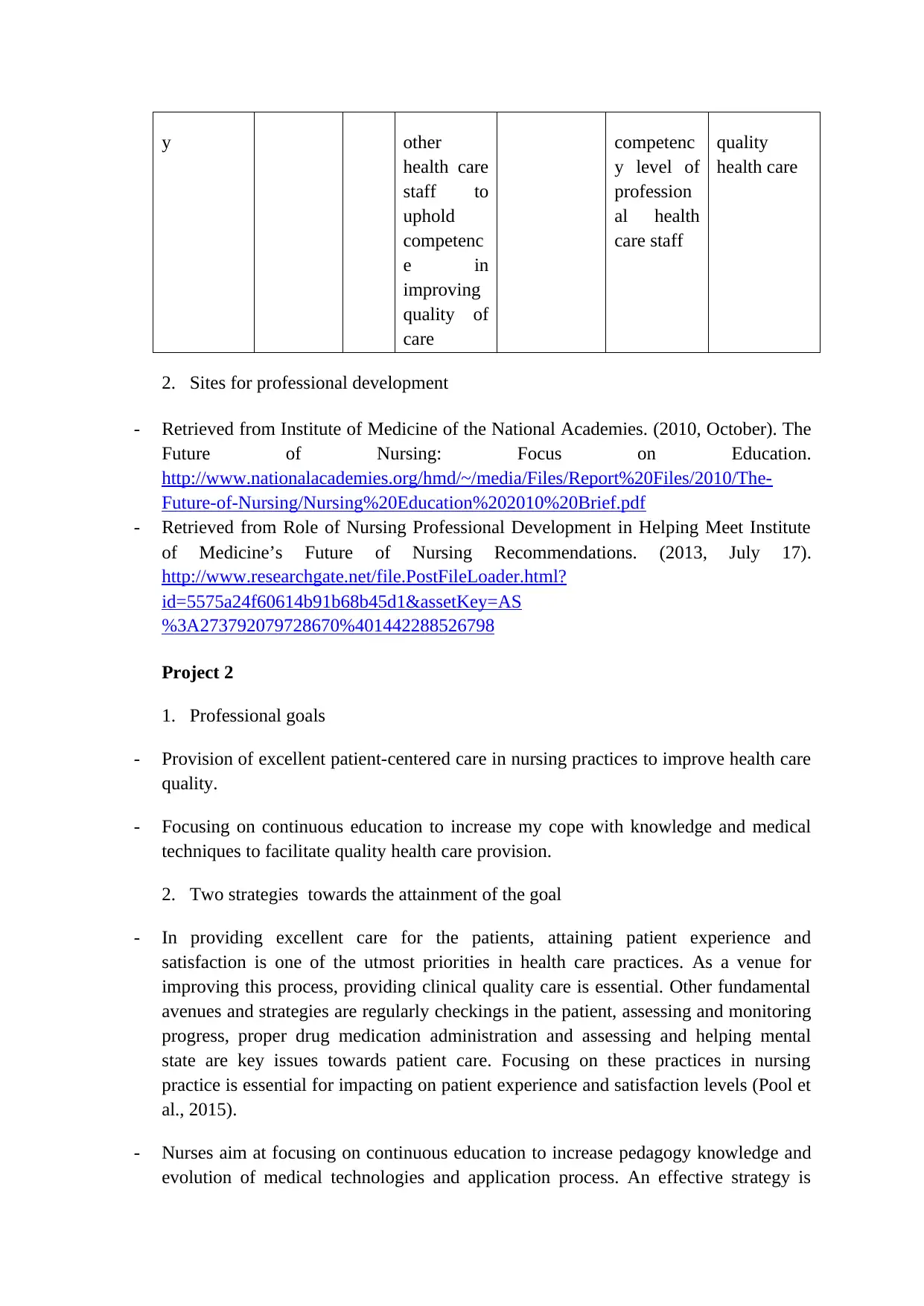
y other
health care
staff to
uphold
competenc
e in
improving
quality of
care
competenc
y level of
profession
al health
care staff
quality
health care
2. Sites for professional development
- Retrieved from Institute of Medicine of the National Academies. (2010, October). The
Future of Nursing: Focus on Education.
http://www.nationalacademies.org/hmd/~/media/Files/Report%20Files/2010/The-
Future-of-Nursing/Nursing%20Education%202010%20Brief.pdf
- Retrieved from Role of Nursing Professional Development in Helping Meet Institute
of Medicine’s Future of Nursing Recommendations. (2013, July 17).
http://www.researchgate.net/file.PostFileLoader.html?
id=5575a24f60614b91b68b45d1&assetKey=AS
%3A273792079728670%401442288526798
Project 2
1. Professional goals
- Provision of excellent patient-centered care in nursing practices to improve health care
quality.
- Focusing on continuous education to increase my cope with knowledge and medical
techniques to facilitate quality health care provision.
2. Two strategies towards the attainment of the goal
- In providing excellent care for the patients, attaining patient experience and
satisfaction is one of the utmost priorities in health care practices. As a venue for
improving this process, providing clinical quality care is essential. Other fundamental
avenues and strategies are regularly checkings in the patient, assessing and monitoring
progress, proper drug medication administration and assessing and helping mental
state are key issues towards patient care. Focusing on these practices in nursing
practice is essential for impacting on patient experience and satisfaction levels (Pool et
al., 2015).
- Nurses aim at focusing on continuous education to increase pedagogy knowledge and
evolution of medical technologies and application process. An effective strategy is
health care
staff to
uphold
competenc
e in
improving
quality of
care
competenc
y level of
profession
al health
care staff
quality
health care
2. Sites for professional development
- Retrieved from Institute of Medicine of the National Academies. (2010, October). The
Future of Nursing: Focus on Education.
http://www.nationalacademies.org/hmd/~/media/Files/Report%20Files/2010/The-
Future-of-Nursing/Nursing%20Education%202010%20Brief.pdf
- Retrieved from Role of Nursing Professional Development in Helping Meet Institute
of Medicine’s Future of Nursing Recommendations. (2013, July 17).
http://www.researchgate.net/file.PostFileLoader.html?
id=5575a24f60614b91b68b45d1&assetKey=AS
%3A273792079728670%401442288526798
Project 2
1. Professional goals
- Provision of excellent patient-centered care in nursing practices to improve health care
quality.
- Focusing on continuous education to increase my cope with knowledge and medical
techniques to facilitate quality health care provision.
2. Two strategies towards the attainment of the goal
- In providing excellent care for the patients, attaining patient experience and
satisfaction is one of the utmost priorities in health care practices. As a venue for
improving this process, providing clinical quality care is essential. Other fundamental
avenues and strategies are regularly checkings in the patient, assessing and monitoring
progress, proper drug medication administration and assessing and helping mental
state are key issues towards patient care. Focusing on these practices in nursing
practice is essential for impacting on patient experience and satisfaction levels (Pool et
al., 2015).
- Nurses aim at focusing on continuous education to increase pedagogy knowledge and
evolution of medical technologies and application process. An effective strategy is
⊘ This is a preview!⊘
Do you want full access?
Subscribe today to unlock all pages.

Trusted by 1+ million students worldwide
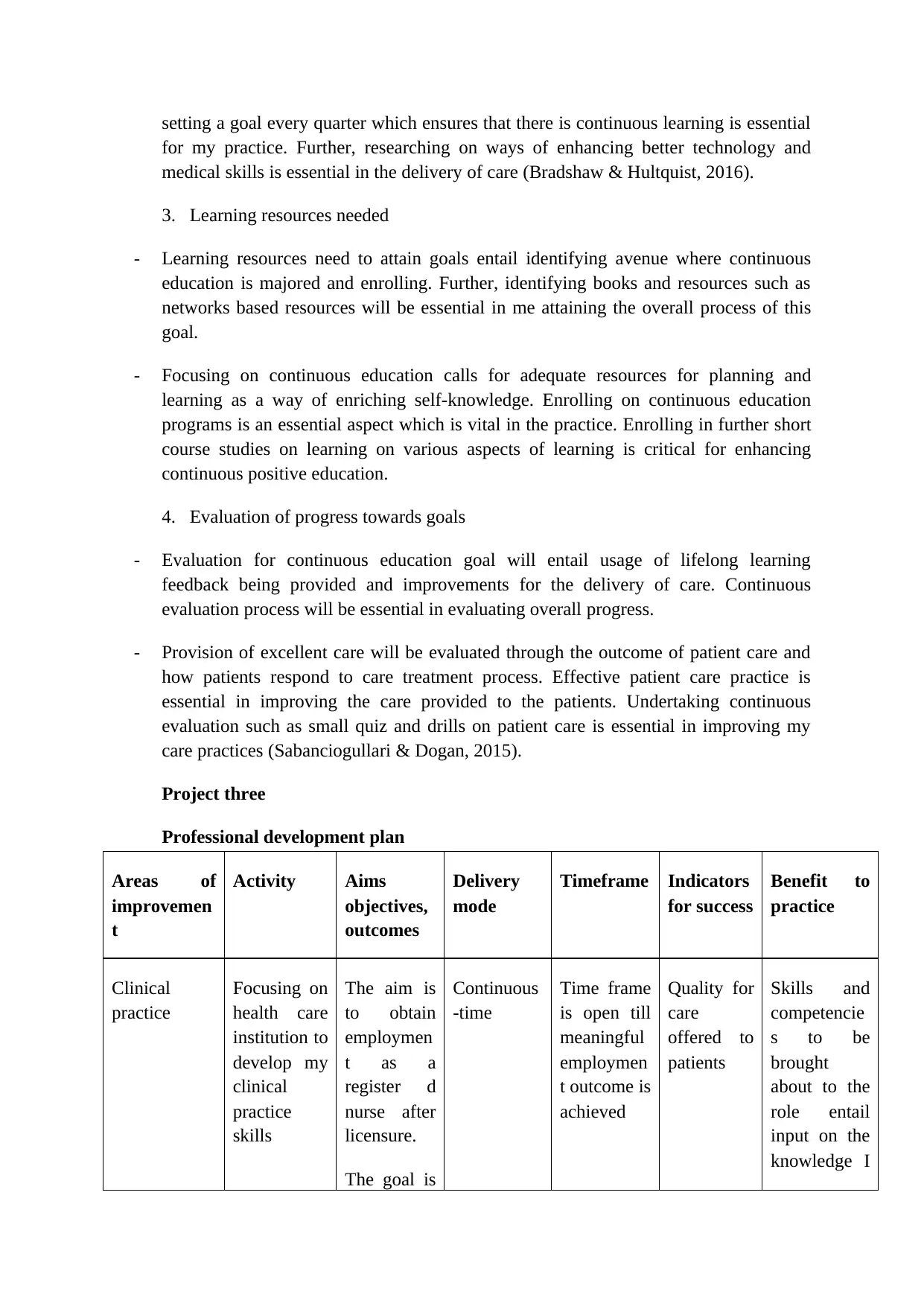
setting a goal every quarter which ensures that there is continuous learning is essential
for my practice. Further, researching on ways of enhancing better technology and
medical skills is essential in the delivery of care (Bradshaw & Hultquist, 2016).
3. Learning resources needed
- Learning resources need to attain goals entail identifying avenue where continuous
education is majored and enrolling. Further, identifying books and resources such as
networks based resources will be essential in me attaining the overall process of this
goal.
- Focusing on continuous education calls for adequate resources for planning and
learning as a way of enriching self-knowledge. Enrolling on continuous education
programs is an essential aspect which is vital in the practice. Enrolling in further short
course studies on learning on various aspects of learning is critical for enhancing
continuous positive education.
4. Evaluation of progress towards goals
- Evaluation for continuous education goal will entail usage of lifelong learning
feedback being provided and improvements for the delivery of care. Continuous
evaluation process will be essential in evaluating overall progress.
- Provision of excellent care will be evaluated through the outcome of patient care and
how patients respond to care treatment process. Effective patient care practice is
essential in improving the care provided to the patients. Undertaking continuous
evaluation such as small quiz and drills on patient care is essential in improving my
care practices (Sabanciogullari & Dogan, 2015).
Project three
Professional development plan
Areas of
improvemen
t
Activity Aims
objectives,
outcomes
Delivery
mode
Timeframe Indicators
for success
Benefit to
practice
Clinical
practice
Focusing on
health care
institution to
develop my
clinical
practice
skills
The aim is
to obtain
employmen
t as a
register d
nurse after
licensure.
The goal is
Continuous
-time
Time frame
is open till
meaningful
employmen
t outcome is
achieved
Quality for
care
offered to
patients
Skills and
competencie
s to be
brought
about to the
role entail
input on the
knowledge I
for my practice. Further, researching on ways of enhancing better technology and
medical skills is essential in the delivery of care (Bradshaw & Hultquist, 2016).
3. Learning resources needed
- Learning resources need to attain goals entail identifying avenue where continuous
education is majored and enrolling. Further, identifying books and resources such as
networks based resources will be essential in me attaining the overall process of this
goal.
- Focusing on continuous education calls for adequate resources for planning and
learning as a way of enriching self-knowledge. Enrolling on continuous education
programs is an essential aspect which is vital in the practice. Enrolling in further short
course studies on learning on various aspects of learning is critical for enhancing
continuous positive education.
4. Evaluation of progress towards goals
- Evaluation for continuous education goal will entail usage of lifelong learning
feedback being provided and improvements for the delivery of care. Continuous
evaluation process will be essential in evaluating overall progress.
- Provision of excellent care will be evaluated through the outcome of patient care and
how patients respond to care treatment process. Effective patient care practice is
essential in improving the care provided to the patients. Undertaking continuous
evaluation such as small quiz and drills on patient care is essential in improving my
care practices (Sabanciogullari & Dogan, 2015).
Project three
Professional development plan
Areas of
improvemen
t
Activity Aims
objectives,
outcomes
Delivery
mode
Timeframe Indicators
for success
Benefit to
practice
Clinical
practice
Focusing on
health care
institution to
develop my
clinical
practice
skills
The aim is
to obtain
employmen
t as a
register d
nurse after
licensure.
The goal is
Continuous
-time
Time frame
is open till
meaningful
employmen
t outcome is
achieved
Quality for
care
offered to
patients
Skills and
competencie
s to be
brought
about to the
role entail
input on the
knowledge I
Paraphrase This Document
Need a fresh take? Get an instant paraphrase of this document with our AI Paraphraser
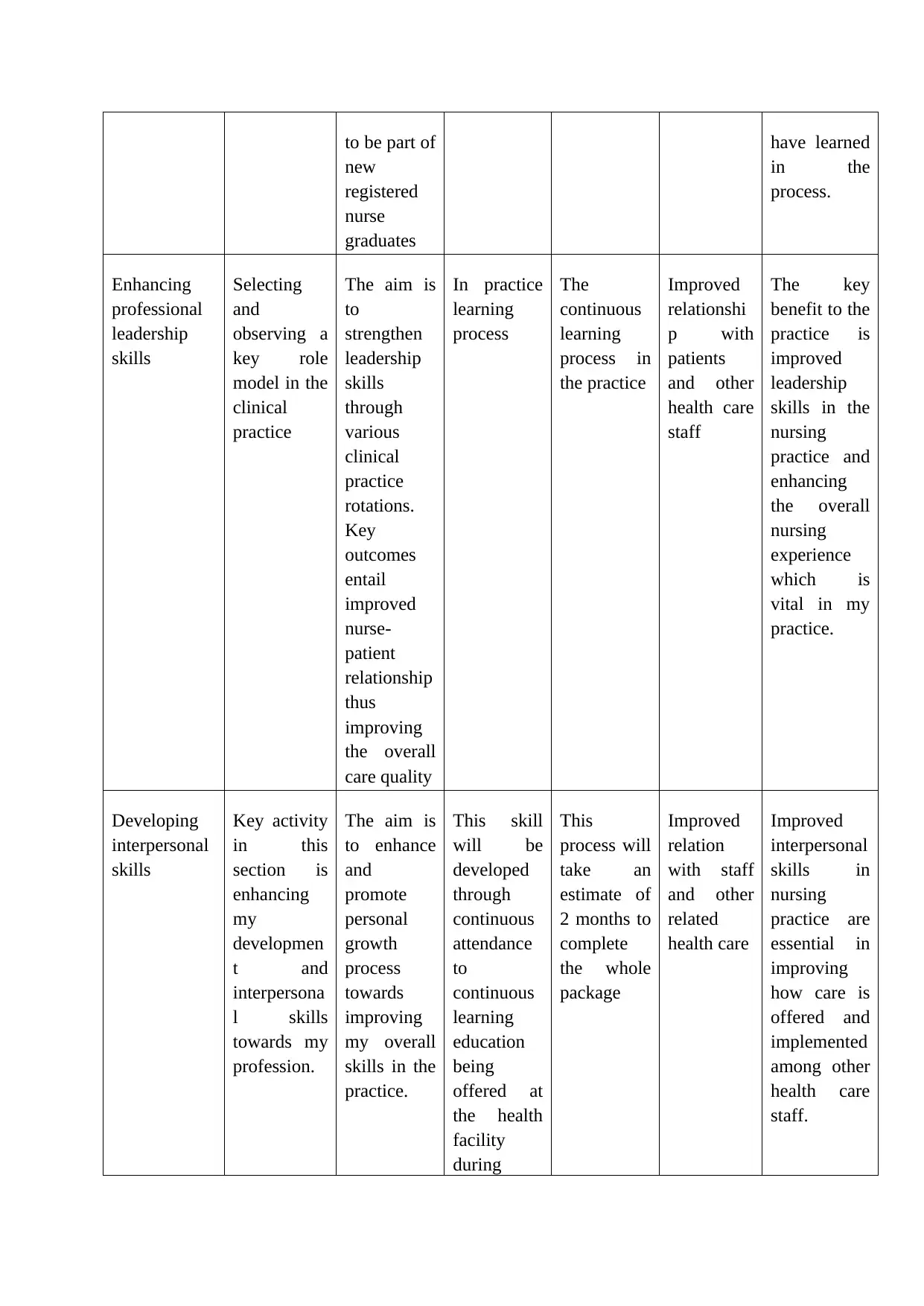
to be part of
new
registered
nurse
graduates
have learned
in the
process.
Enhancing
professional
leadership
skills
Selecting
and
observing a
key role
model in the
clinical
practice
The aim is
to
strengthen
leadership
skills
through
various
clinical
practice
rotations.
Key
outcomes
entail
improved
nurse-
patient
relationship
thus
improving
the overall
care quality
In practice
learning
process
The
continuous
learning
process in
the practice
Improved
relationshi
p with
patients
and other
health care
staff
The key
benefit to the
practice is
improved
leadership
skills in the
nursing
practice and
enhancing
the overall
nursing
experience
which is
vital in my
practice.
Developing
interpersonal
skills
Key activity
in this
section is
enhancing
my
developmen
t and
interpersona
l skills
towards my
profession.
The aim is
to enhance
and
promote
personal
growth
process
towards
improving
my overall
skills in the
practice.
This skill
will be
developed
through
continuous
attendance
to
continuous
learning
education
being
offered at
the health
facility
during
This
process will
take an
estimate of
2 months to
complete
the whole
package
Improved
relation
with staff
and other
related
health care
Improved
interpersonal
skills in
nursing
practice are
essential in
improving
how care is
offered and
implemented
among other
health care
staff.
new
registered
nurse
graduates
have learned
in the
process.
Enhancing
professional
leadership
skills
Selecting
and
observing a
key role
model in the
clinical
practice
The aim is
to
strengthen
leadership
skills
through
various
clinical
practice
rotations.
Key
outcomes
entail
improved
nurse-
patient
relationship
thus
improving
the overall
care quality
In practice
learning
process
The
continuous
learning
process in
the practice
Improved
relationshi
p with
patients
and other
health care
staff
The key
benefit to the
practice is
improved
leadership
skills in the
nursing
practice and
enhancing
the overall
nursing
experience
which is
vital in my
practice.
Developing
interpersonal
skills
Key activity
in this
section is
enhancing
my
developmen
t and
interpersona
l skills
towards my
profession.
The aim is
to enhance
and
promote
personal
growth
process
towards
improving
my overall
skills in the
practice.
This skill
will be
developed
through
continuous
attendance
to
continuous
learning
education
being
offered at
the health
facility
during
This
process will
take an
estimate of
2 months to
complete
the whole
package
Improved
relation
with staff
and other
related
health care
Improved
interpersonal
skills in
nursing
practice are
essential in
improving
how care is
offered and
implemented
among other
health care
staff.
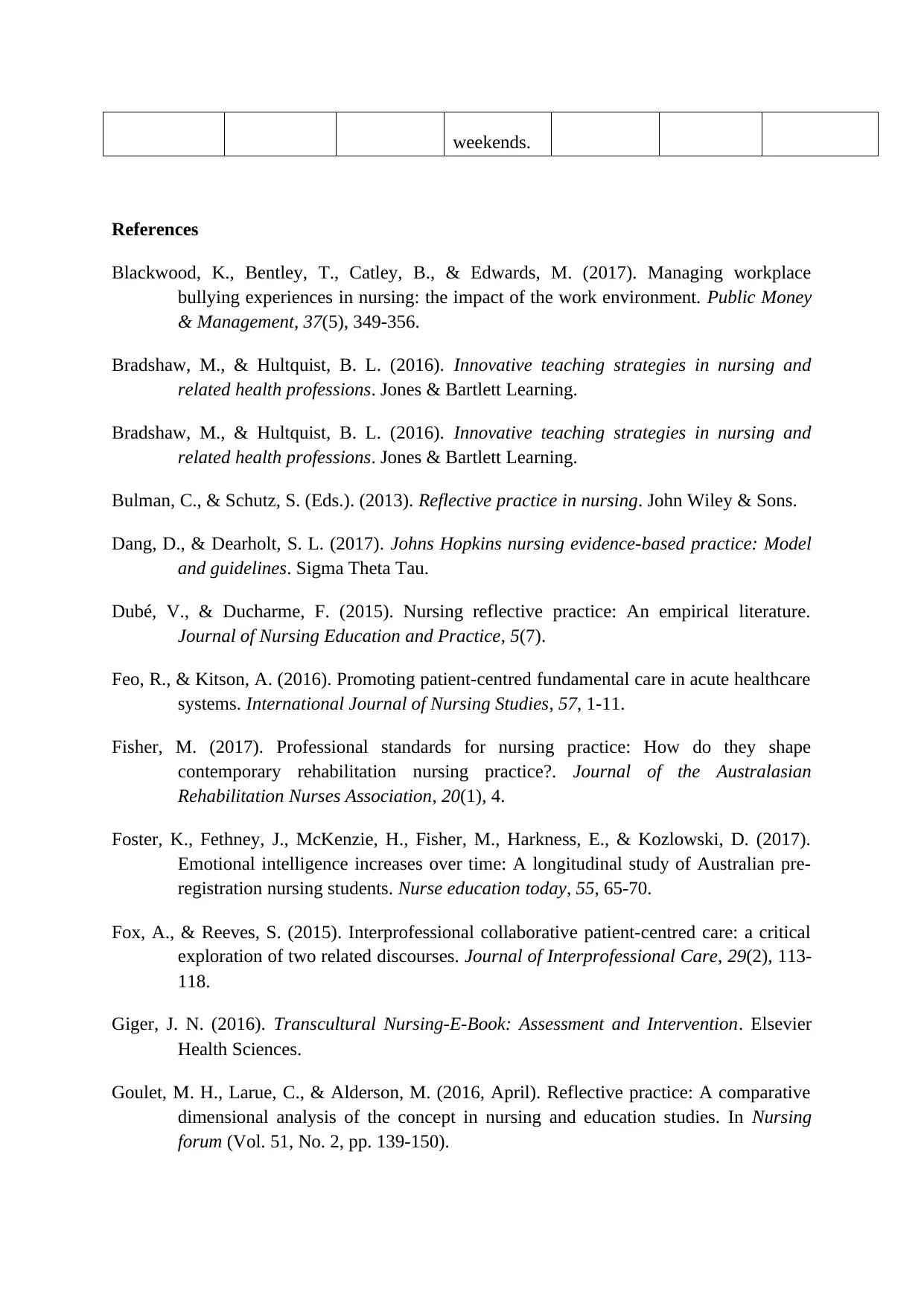
weekends.
References
Blackwood, K., Bentley, T., Catley, B., & Edwards, M. (2017). Managing workplace
bullying experiences in nursing: the impact of the work environment. Public Money
& Management, 37(5), 349-356.
Bradshaw, M., & Hultquist, B. L. (2016). Innovative teaching strategies in nursing and
related health professions. Jones & Bartlett Learning.
Bradshaw, M., & Hultquist, B. L. (2016). Innovative teaching strategies in nursing and
related health professions. Jones & Bartlett Learning.
Bulman, C., & Schutz, S. (Eds.). (2013). Reflective practice in nursing. John Wiley & Sons.
Dang, D., & Dearholt, S. L. (2017). Johns Hopkins nursing evidence-based practice: Model
and guidelines. Sigma Theta Tau.
Dubé, V., & Ducharme, F. (2015). Nursing reflective practice: An empirical literature.
Journal of Nursing Education and Practice, 5(7).
Feo, R., & Kitson, A. (2016). Promoting patient-centred fundamental care in acute healthcare
systems. International Journal of Nursing Studies, 57, 1-11.
Fisher, M. (2017). Professional standards for nursing practice: How do they shape
contemporary rehabilitation nursing practice?. Journal of the Australasian
Rehabilitation Nurses Association, 20(1), 4.
Foster, K., Fethney, J., McKenzie, H., Fisher, M., Harkness, E., & Kozlowski, D. (2017).
Emotional intelligence increases over time: A longitudinal study of Australian pre-
registration nursing students. Nurse education today, 55, 65-70.
Fox, A., & Reeves, S. (2015). Interprofessional collaborative patient-centred care: a critical
exploration of two related discourses. Journal of Interprofessional Care, 29(2), 113-
118.
Giger, J. N. (2016). Transcultural Nursing-E-Book: Assessment and Intervention. Elsevier
Health Sciences.
Goulet, M. H., Larue, C., & Alderson, M. (2016, April). Reflective practice: A comparative
dimensional analysis of the concept in nursing and education studies. In Nursing
forum (Vol. 51, No. 2, pp. 139-150).
References
Blackwood, K., Bentley, T., Catley, B., & Edwards, M. (2017). Managing workplace
bullying experiences in nursing: the impact of the work environment. Public Money
& Management, 37(5), 349-356.
Bradshaw, M., & Hultquist, B. L. (2016). Innovative teaching strategies in nursing and
related health professions. Jones & Bartlett Learning.
Bradshaw, M., & Hultquist, B. L. (2016). Innovative teaching strategies in nursing and
related health professions. Jones & Bartlett Learning.
Bulman, C., & Schutz, S. (Eds.). (2013). Reflective practice in nursing. John Wiley & Sons.
Dang, D., & Dearholt, S. L. (2017). Johns Hopkins nursing evidence-based practice: Model
and guidelines. Sigma Theta Tau.
Dubé, V., & Ducharme, F. (2015). Nursing reflective practice: An empirical literature.
Journal of Nursing Education and Practice, 5(7).
Feo, R., & Kitson, A. (2016). Promoting patient-centred fundamental care in acute healthcare
systems. International Journal of Nursing Studies, 57, 1-11.
Fisher, M. (2017). Professional standards for nursing practice: How do they shape
contemporary rehabilitation nursing practice?. Journal of the Australasian
Rehabilitation Nurses Association, 20(1), 4.
Foster, K., Fethney, J., McKenzie, H., Fisher, M., Harkness, E., & Kozlowski, D. (2017).
Emotional intelligence increases over time: A longitudinal study of Australian pre-
registration nursing students. Nurse education today, 55, 65-70.
Fox, A., & Reeves, S. (2015). Interprofessional collaborative patient-centred care: a critical
exploration of two related discourses. Journal of Interprofessional Care, 29(2), 113-
118.
Giger, J. N. (2016). Transcultural Nursing-E-Book: Assessment and Intervention. Elsevier
Health Sciences.
Goulet, M. H., Larue, C., & Alderson, M. (2016, April). Reflective practice: A comparative
dimensional analysis of the concept in nursing and education studies. In Nursing
forum (Vol. 51, No. 2, pp. 139-150).
⊘ This is a preview!⊘
Do you want full access?
Subscribe today to unlock all pages.

Trusted by 1+ million students worldwide
1 out of 13
Related Documents
Your All-in-One AI-Powered Toolkit for Academic Success.
+13062052269
info@desklib.com
Available 24*7 on WhatsApp / Email
![[object Object]](/_next/static/media/star-bottom.7253800d.svg)
Unlock your academic potential
Copyright © 2020–2025 A2Z Services. All Rights Reserved. Developed and managed by ZUCOL.


![Nursing Profession Reflection Report - [University/College Name]](/_next/image/?url=https%3A%2F%2Fdesklib.com%2Fmedia%2Fimages%2Fxu%2F72b5ecdeb9cd4b09bfa05c90ebf133a4.jpg&w=256&q=75)


